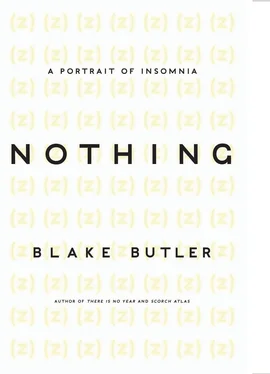Prior even to the laying down for sleeping in want of blank mind, the house and what it holds go on and on. The walls, doors, ovens, knives, etc.; they don’t sleep, and do not wish to. They are there. In each room, each inch and object holds a hundred thousand potential questions, each of which might overlap: who why moving in what space and who before them and who before? Even in homes sequestered to their own walls, sharing nothing, there is the residue of shifting forms, the sounds that move within a house at night, those other people there, awake. There is place and there is time though both are always changing. Regardless of to what degree one may or may not attend these minute methods of every hour, they remain alive, awake around the body.
The bulk of any house is made of air. Subjects in sleep lab testing procedures have been found, out of their usual element, to exhibit the same mood and personality shift whether they had trouble sleeping there or not, despite the fact that the unsleepers did indicate higher heart rates, higher body temperatures, and accelerated nervous systems.3 Even lab rats, when placed in cages previously occupied by other male rats, have been found to experience a longer period of sleep onset (fifty-nine minutes versus an average, regularly thirty-two) as well as hyperaroused EEG recordings.4 In humans the subjective complaints are more difficult to read, even from inside the self, and yet the space of where we sleep, regardless of internal condition, clearly distinctly matters. Upon the air, beyond its elements, there travels sound and light and the unseen: cells we breathe in without knowing, cycled among the buildings, over years — dust of human, breath of human, hair of human, bacterial surge — as well as the flood of signals beeping back and forth between us, communication of the objects, silent speech — transmission, higher pitches, the presence of a presence, or the idea of the presence, or the intimation of something coming nearer, waiting.
Sound : we give names to anything in ways we share, or the tremor of an object’s wobble, or system of the night. In their later years, my grandmother knew my grandfather still stayed around her in the evenings after he had passed, hearing his breathing, a residual of what was so long known. Children might be soothed to calm by music playing, as if the sound itself is someone there, or perhaps designed to cover up the teeming billions of all others looming in a silence: how much more terrifying a house can be when nothing’s moving, as if every instant is the instant before some awful lurch. Even there within the pillow, if one listens clearly, there is the encroaching sound of some parading ream of drums, a rhythmic echo pushed out from the body into the pillow, the intoned heartbeat replayed into the head. Every bump or blow or itch of room around the body is magnified by several times. Most nights I run a white noise machine beside my bed: a singular screen over the stutters of the surrounding of the night. The context of the sound carries its purpose: if I am its master, it might sing to me, while if it is beyond control, it owns my air. A perfect silence might seem ancient, graceful, though also, by its facelessness, in some, a menace, aimed to eat, pervaded as by a thing that shines too bright.
And therefore, Light : in each phase of those nightly nighted hours, there looms the premonition that the sun will not come back — that, in its burning, it will burn up at last, those last hours therein unknown for how the light still travels across such time — and thereafter leave the breadths and widths of our sunk cities therein forever under, wadded, stunned. Light of billboards, headlamps, streetlights and signs and human-held lights briefly unblinking, create false tunnels of the space that seemed so plain and clean in day, the light of passing, turned on rooms and bars and businesses, scanning some small part of the immense face of a dark mountain. Forget the moon and drowning stars, so worn out against glowing that they often appear not at all, or show up dead. At night, the earth does something different, as if underwater, a mottled mirror of the environment of day, as through the same spheres and bowls and bells of buildings, windows, streets, arches, and cars appear, same in their sinking to the no-light as in any shining, in the night they appear other, covered over, thick. In dark, the new folds to any room, the innards of a previously translucent body become suddenly opaque. We learn to spend most rotating states of light in day and evening as one negotiates the features of a skin, a home. And yet, always more doors. Always odd sounds. Another hole within a hole within a hole, in and around any home, a disease communicable through any body without symptom. Light is that by which we might know or not know what is just beside us. Go or do not go toward. The cloak and the revealer.
In the house I grew up in I was always looking for an extra door: a split or seam or button in the building that had been hid there, waiting to be invoked. Awake late, in the silence, I spent hours rubbing along walls, reaching armlong down an air vent or under cushions, after all. In absence of finding any new surface, I would summon up my own — affixing keys from machines or bits of wires onto the household, waiting for where they might sink in, or digging in the yard for something just there beneath the surface. I dreamt many nights of excavating the whole yard, surrounding where we slept with mud drifts down to nothing, to the center of the earth. A map I drew one year of my mother’s parents’ house featured a long corridor on the far side of the concrete wall, which I fantasized of finding some way into, never to return.
Other young nights, caught up again in faceless terror, I’d crawl along the floor into my parents’ bedroom to curl hunched in the space below their bed. Each evening I would wait a long enough period after they’d stopped watching TV and retired that they might fully be asleep. I was supposed to be by now old enough to keep to my own bed; as soon as enough time had passed — time I waited through feeling the whole house around me, as if about to shake, I would crawl and wriggle careful along the lip of hallway from my room to their room, each slow inch by inch pushed forward in as close toward zero sound as I could manage — my mother had always been a light sleeper and would often sit up while I was en route, demand me back into my own (not always, sometimes, she let me, she understood), these catching moments requiring me to move even slower the next time I tried, even more silent. It might take twenty minutes moving the eight feet from their door to the stretch along the low foot of their bed — they had a poster bed by this point, king-sized, about two feet off the ground — god it seemed so much taller then than when I go to stand before it now. In the fold of night I would not go underneath the bed but tuck myself just far enough up near its butt-end that I could not be seen from where my parents lay face up above me, closed eyed heads aimed toward a skylight cut in the ceiling, glowing through the room.
Once in position there on the carpet, still in silence, I would begin to position my flesh into some comfortable contortion, bringing my head and arms and body together in minute positioning, still being careful not to move too fast, erupt in sound. This period was often, perhaps surprisingly, the one in which I would most often be apprehended, some shift near the bed itself bringing my mother into sudden awareness of her nearer air. I had to be extremely attentive to each inch of my arms’ or thighs’ dragged moving, rubbed on the carpet, friction sound. I had to adjust myself, even just to gather the semblance of a sleep position, pull by pull and pick by pick, slowly dragging the extremities and angles of my body into fetal, nighttimey. In that way it might take twice as long as it had taken to crawl from my door to the floor there to get myself tucked into a half-position I could therein begin to try to eke my way off into sleep, absolved at last of the coiled fervor the house enforced around me awake alone at night except in the presence of my makers. Sometimes I’d manage to drag along a blanket or pillow with me, but often these accoutrements made it more difficult to pass by without being heard, so I would abandon them for simply arriving in that blank-of-terror space. There — slow, careful, as if not underwater but held close against some massive still — there, however many minutes, hours, later — I at last, within and for myself, could sleep — if at the same time teaching my blood to enjoy the elongation, to rest only after some extended vapid thrall. Those were the nights I remember feeling safest, nearest, most open to the sound. Those, of all the nights I’ve slept, despite the odd shape, were likely hours that, if I chose out of all those I’ve glued through, would be the ones I would put on pause, and replicate in texture and sound forever, every evening, stretched right as the greatest kind of warming light.
Читать дальше












